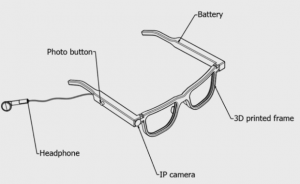Free glasses for the blind sounds like an altruistic dream, but the Indiegogo that launched with this very premise hasn’t started well.
It sounded like a wonderful goal, helping the poorest people in the world overcome their disability and live a better life with the help of technology. Parsee promised to bring us battery-powered smart glasses with the help of 3D printing and make this philanthropic vision a reality.
The glasses are slick
That sounds seriously slick and the smart glasses really do sound like clever technology.
Users can take a picture of the world in front of them with an IP connected camera in the 3D printed glasses, which feeds into the app. It can then give them audio information through an earphone that is an integral part of the system.
The app can recognise faces, shapes and colours. The company claims it could even help a totally blind person to read a newspaper and included a perfectly spoken version of a newspaper extract in the promotional video. So there’s no doubt this could change lives.
We expected more from the fundraising campaign
The first prototype is a little rough around the edges, but it looks perfectly practical, it fits a clear need and we’d expect to see this one going through the roof and smashing its goal in days. There are 300 million people around the world that suffer with serious eyesight problems and many of them simply cannot afford traditional glasses.
“It helps (the blind and visually impaired) in their everyday living like reading newspapers, drinking juice,” Parsee project manager Bartosz Trzcinski said.
So it’s a noble cause and clever technology. That makes its initial impact on Indiegogo, or lack thereof, is a bit of a mystery.
Is the price the big issue?
The company is looking for $25,000 to assist in product development and there is only one major sticking point right now. Each pair of glasses costs $314 right now, which might be simply too much for the intended market to cope with.
It has just five backers so far and has collected just 1% of the target, which is a relative disaster considering the project has received international press coverage.
It’s a major jump from $314 a pair to a free supply for the world’s poorest blind people and that may be a stumbling block here. The Polish company insists it is looking for ways to reduce the price during the development phases and that when they are ready for general release it will find a way to work with charities to find a solution to provide them for free.
Maybe a simpler start would have been smarter?
This might have been a step too far to begin with, though, and it may have been wiser to simply market these glasses as a product for the blind. Perhaps the altruistic goals, noble as they are, have made a rod for its own back in the early fundraising stages.
There are others working on a similar concept, too. In the UK the Royal National Institute of Blind People is working with researchers to make glasses that recognise shapes and determine distances. Its glasses could cost more than $400 when they finally hit the market, though. So this technology is never going to be cheap.
Time to get this one back
There’s still a month left, there is plenty of time to turn this around and we hope that Parsee pulls it off.
This is an interesting product that used modern technology to help people overcome an age-old and debilitating problem. We think this project could work in the end. We wish them well.



